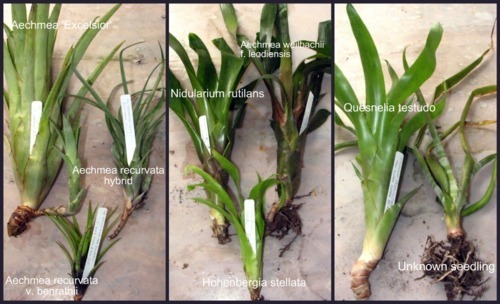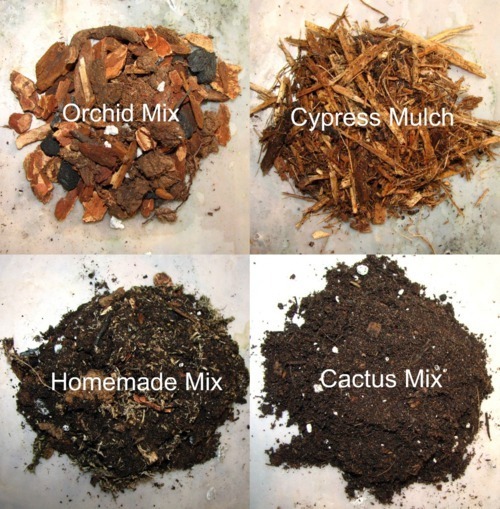 lavenderlens liked this
lavenderlens liked this peachy-keem liked this
batesnursery liked this
iwanthatone liked this
silentropae-blog liked this
k0shka174 liked this
 mattdoux liked this
mattdoux liked this bromeliace posted this
Potting up Bromeliads Tutorial
On Thursday, I received eight new plants in the mail, so I figured I would make a post on how I usually pot up bromeliads!
First you have to start with clean, healthy plants. If they are offsets that have been divided, they need to callous over for a week in a cool, dry place.

- Aechmea ‘Excelsior’ - This is an Aechmea recurvata hybrid, relatively common in California gardens, it’s been around since the 1970’s, it’s a big plant, almost 16 inches tall.
- Aechmea recurvata hybrid - I don’t really know much about this one, but it seems like it’s going to be a small plant, it has cool, twisted leaves.
- Aechmea recurvata v. benrathii - This is a small plant, cold hardy and able to take full sun, when it flowers the whole plant blushes hot pink.
- Aechmea weilbachii f. leodiensis - This plant has a red tinge to the leaves, so it should do well in part shade, it should mature to a somewhat large plant, and has a red inflorescence with purple flowers.
- Nidularium rutilans - This plant is supposed to be cold hardy to around 26*F with only minor damage, it has spotted leaves and has a red star shaped inflorescence.
- Hohenbergia stellata - This plant, when not in flower, is relatively boring, with long, strappy, green leaves, it forms large clumps in time, when in bloom it has tall red spikes.
- Quesnelia testudo - In general, quesnelias have spiny, banded leaves, are easy to grow, and have stunning flower spikes, Q. testudo is no different, with a hot pink inflorescence, that usually shows up in spring.
- Unknown seedling - I don’t know much about this one either, the person who gave it to me thinks it is a billbergia seedling, it has very succulent leaves, with heavy cross banding.
Next you need pots. Most of these plants will be going into the garden in the spring, so I put them in plastic pots until then.

When potting up bromeliads, it’s important to remember these things:
- Always use clean pots.
- Make sure they have drainage holes.
- Plastic pots dry out slower than clay pots - if you live in a wet area or water frequently, it may be beneficial to pot your bromeliads in clay pots.
- Don’t over pot bromeliads - in general, they only use their root systems for anchorage, so it’s best to under pot them to prevent rot.
- Know what potting medium your plants like - that is, know if they are an epiphytic species or a terrestrial species.
- Don’t plant your bromeliads too deeply, or else they may rot - generally they should be planted no deeper than the base of their leaves.
Next you need a potting medium. I’ve personally used all of these; depending on where you live, you may find a better potting medium, either from local materials, or your own made mix.

- Orchid Mix - this is widely available at most garden centers, since it’s coarse it’s best used for bromeliads that are highly epiphytic or for plants that have a tendency to rot if watered too much - this includes: some aechmea’s, billbergia’s, hohenbergia’s, quesnelia’s, and neoregelia’s; and most grey leaved tillandsia’s, if they must be potted.
- Cypress Mulch - also widely available at garden centers, most bromeliads can be grown in this medium, since it still allows for plenty of drainage, stays slightly moist all the time, and is slightly acidic which most bromeliads appreciate - almost all epiphytic bromeliads can be grown in this, including: aechmeas, billbergia’s, neoregelia’s, quesnelia’s, and vriesea’s.
- Cactus Mix - again, widely available at garden centers, it’s made for cacti and succulents, but terrestrial bromeliads can also be grown in this mix, which is fast draining and usually has fertilizer mixed in - terrestrial bromeliads incude: ananas (pineapples), dyckia’s, cryptanthus, and some hechtia.
- Homemade Mix - my homemade mix is part cactus mix, part orchid mix, part expanded clay pellets, and part sphagnum moss (but your homemade mix will probably be different); this mix is for more moisture loving plants, but is still fast draining enough to hopefully prevent rot - plants that can be grown in this mix include: guzmania’s, cryptanthus, some vriesea’s, and the green leaved tank type tillandsia’s.
Sometimes it’s necessary to stake your plants when you pot them up. These are old kitchen skewers, but you can use bamboo stakes, chop sticks, or even stones. Never use metal that is rusty, or anything made of copper or zinc, it’s toxic to bromeliads, and will kill them. Staking your plants will prevent them from wobbling, helping the roots get established.

Lastly, don’t forget to water your plants really well after you pot them up!
I don’t have a picture of that, because it’s winter, and it’s best to not water bromeliads a lot during the winter, since cold and wet usually leads to rot. When it warms up in a couple of days, I’ll make sure to water them.